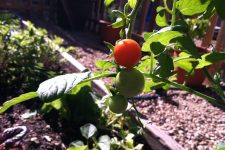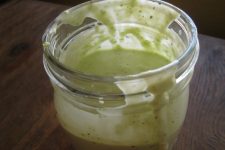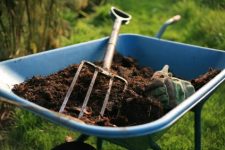Container gardens.
Small spaces.
High yields.
Are you new to gardening?
Or perhaps…you’re looking for easy to grow varieties of fruits and vegetables that will provide you the most abundant harvest while requiring minimal effort?
The following fruits and vegetables are ones that I have found to be best suited for a variety of growing conditions and climates, heavy producers, low maintenance, and perfect for small gardens.
These organic varieties come recommended as the seed companies that sell them have signed The Safe Seed Pledge. The Pledge allows businesses to declare that they “do not knowingly buy, sell or trade genetically engineered seeds,” giving assurance to the consumer.
So far, over 100 commercial seed sellers have joined this growing movement for agricultural sustainability — committing to this statement:
Agriculture and seeds provide the basis upon which our lives depend. We must protect this foundation as a safe and genetically stable source for future generations.
For the benefit of all farmers, gardeners and consumers who want an alternative, we pledge that we do not knowingly buy, sell or trade genetically engineered seeds or plants.
The mechanical transfer of genetic material outside of natural reproductive methods and between genera, families or kingdoms, poses great biological risks as well as economic, political, and cultural threats.
We feel that genetically engineered varieties have been insufficiently tested prior to public release. More research and testing is necessary to further assess the potential risks of genetically engineered seeds.
Further, we wish to support agricultural progress that leads to healthier soils, genetically diverse agricultural ecosystems and ultimately healthy people and communities.
Plants for Small Gardens
1. Beans
2. Carrots
3. Cucumbers
4. Eggplant
5. Greens
6. Melons
7. Peas
8. Peppers
9. Summer Squash
10. Tomatoes
How To Get Started Gardening
Read.
The more you learn about gardening the more successful you will be.
- How to Grow More Vegetables Than You Ever Thought Possible on Less Land Than You Can Imagine
- Carrots Love Tomatoes: Secrets of Companion Planting for Successful Gardening
- Vertical Gardening: Grow Up, Not Out, for More Vegetables and Flowers in Much Less Space
Determine the date of your last frost and your hardiness zone
Vegetable seeds such as eggplant, tomatoes, and peppers take a significantly longer time to germinate than others. A safe guess would be to start these seeds 6-8 weeks before the last frost in your area. The others can be sown directly into the soil where they will grow permanently.
I suggest reading the package labels of the seeds and/or look through those books I mentioned above to determine when the appropriate planting time should be.
Find average frost dates for your last spring frost HERE for the U.S. and HERE for Canada
Organic Seed Starter
Source some nutrient-rich soil for starting your seeds. Look locally through Local Harvest or go with a seed starter like this (this is the one I use personally):
Once I get ready to transplant the seedlings to larger pots on the patio, I have EXCELLENT growth rates using a combination of FoxFarm Ocean Forest Organic Potting Soil and Dr Earth All Purpose Compost. Note: All this stuff ships for FREE if you’re an Amazon Prime Member! I love it and it saves me a TON of money! Click here to try it FREE for a month!
Seedling Trays and Pots
I love using these Biodegradable Transplantable Seed Starting CowPots placed into these Perfect Garden Seed Starter Grow Trays.
Label
For goodness sakes…don’t forget to label the pots! I can’t tell you how many times I’ve not labeled things simply because I was sure I’d remember or at the very least recognize the plant once grown. Trust me…it’s just easier to label!
Warmth and Light
It’s always the best practice to read the seed packet to see the what the optimum germination temperature is. But…if you can’t find it, 60-80F is pretty standard. And of course, the seedlings need light. Frugal Tip: Don’t spend money on grow lights unless you’re into a big growing operation. A windowsill with good light streaming in is perfect. You can however, use a humidity dome on the seedling to keep them warmer and more moist (I need this in our dry desert climate).
Through my studies at the Herbal Academy of New England — I am gaining an incredible amount of knowledge regarding herbs and nutritionally dense foods as medicine! This alone is challenging me to grow even more of my family’s food this year!
No matter how big/small your garden is…there’s always room for one more pot!
Looking for an all in one heirloom organic, non-GMO garden seed kit? The Bulk Herb Store has some very good ones.
What are your favorite fruit & vegetable plants for small gardens?





 DIY Herbal Sore Throat Spray {with raw buckwheat honey, herbs, and essential oils}
DIY Herbal Sore Throat Spray {with raw buckwheat honey, herbs, and essential oils}
What an excellent, meaty post about gardening for newbies (and even old-timers!). It’s about that time . .. gardening season is coming, and I couldn’t be happier about it! Great stuff here, and I’ll share it on my facebook page!
Excellent post for those of us who love gardening, and need your expert advice! Greatly appreciated! Keep up the good work!
Been thinking about what to plant in our buckets this year, this gives me some great ideas. Last year we had sungold cherry tomatoes and pink tie dye tomatoes that both did very well. We had a cayenne that did well also, in fact it is -20 wind chill outside and the cayenne is just inside the door with new blooms! The basil and thyme did great. Dill did ok, but probably should be in the ground.
We live on 10 acres and love our big garden, but I did container gardens for many years while waiting for the farm dream to come true. I’m sending this to my sister who lives in an apartment with a south facing balcony that’s just begging for a garden this year!!!
Nice post for the time of year when everyone has cabin fever and we are all waiting for green. Wonderful pointers.
Nice selection; just one question; did you grow all these varieties, or simply curate the list? I like to grow what others have real experience with growing, before buying the seeds. Thanks!
This is really helpful, I have a little room out on my balcony for growing a few veggies, I might add some of these to my list this year!
Last year I grew a fantastic crop of potatoes in a very narrow strip of garden down the side of my house. They were surprisingly easy to grow and tasted fantastic!